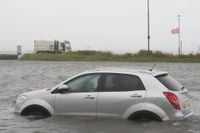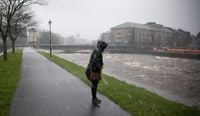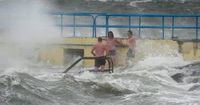Storm Amy unleashed its full force across Ireland and parts of the UK on October 3, 2025, leaving a trail of destruction, widespread power outages, and tragic loss of life in its wake. The storm, the first named of the season, battered the island with gale force winds and torrential rain, prompting the highest-level weather warnings and forcing authorities to mobilize emergency responses on an unprecedented scale.
According to BBC reporting, every county across the island of Ireland was placed under some level of weather warning as Storm Amy swept through. The most severe red warning was issued for County Donegal from 16:00 to 18:00 local time, later downgraded to orange, with authorities urging residents to shelter indoors. The Republic of Ireland’s national forecaster, Met Éireann, also issued status red, orange, and yellow warnings, covering not only land but also marine areas, as violent storm force 11 winds were forecast from Loop Head to Rossan Point to Fair Head between 14:00 and 20:00.
The human toll of the storm was felt acutely in Letterkenny, County Donegal. Gardaí confirmed that a man in his 40s died in what they described as a "weather-related incident" at a home shortly after 16:15. The incident, which emergency services responded to promptly, is undergoing a post-mortem examination to determine the precise circumstances. In a separate but related event, another man sustained serious injuries in Letterkenny during the same period, with authorities treating the case as directly linked to the severe weather conditions, as reported by The Independent.
Power infrastructure bore the brunt of Storm Amy’s wrath. The Electricity Supply Board (ESB) reported that nearly 200,000 homes, farms, and businesses across the Republic of Ireland lost electricity as the storm raged. The worst-hit areas included Donegal, Galway, Mayo, Sligo, Roscommon, Leitrim, and Cavan. By the evening, more than 100,000 customers still remained without power, with ESB warning that hazardous conditions and accessibility challenges would likely delay restoration until after the storm subsided. “Crews will continue the restoration work for as long as possible this evening, but it is likely that the majority of customers will not have their power restored tonight due to the hazardous weather conditions and accessibility challenges,” an ESB spokesperson told The Independent.
Travelers faced chaos as the storm disrupted both air and ground transportation. At Dublin Airport alone, 58 flights were cancelled and nine inbound flights diverted to other airports by 17:00, according to BBC and Irish Examiner. Cork Airport also experienced delays and cancellations, including Lufthansa flights to and from Frankfurt. Other flights were diverted to Shannon and London Stansted. Road travel was treacherous, with fallen trees blocking key routes, including part of the M1 motorway. The Police Service of Northern Ireland advised motorists to reconsider travel plans, reduce speed, and exercise extreme caution.
Schools across a large part of Northern Ireland closed early, prioritizing the safety of students and staff as wind speeds soared. The UK Met Office had issued a yellow wind warning for the entire region from 14:00 on Friday until midnight, with an amber wind warning for counties Antrim, Fermanagh, Tyrone, and Londonderry between 15:00 and 20:00. A yellow rain warning was also in effect until midday Saturday, raising concerns over possible flooding of homes and businesses.
Wind speeds reached staggering levels, with a provisional record gust of 148 km/h (approximately 92 mph) recorded in Northern Ireland on October 3, 2025, as noted by The Irish Times. Met Éireann and the UK Met Office both warned that gusts could reach up to 80 mph (130 kph) along the most exposed coasts, increasing the risk of fallen trees, damage to buildings, and flying debris. In Donegal, gusts of up to 80 mph were recorded at Malin Head at 15:00, while consistent winds of 55 mph battered other parts of the county.
Flooding, fallen trees, and structural damage became common sights across the island. Localized flooding submerged vehicles in car parks, as seen in Galway, and waves crashed over coastal infrastructure, prompting warnings from the Irish Coast Guard to "Stay Back, Stay High, Stay Dry." Emergency management teams activated severe weather protocols in multiple counties, and local authorities urged the public to monitor ongoing advice and avoid unnecessary travel, especially near coastal areas.
Keith Leonard of the National Directorate for Fire and Emergency Management emphasized the seriousness of the situation in a statement carried by Irish Examiner: “It is quite clear that we will have challenging weather conditions at local level in many counties. Local Authority severe weather teams are activated and are preparing for the storm’s approach. For those in areas affected, I would advise they pay attention to their local conditions and members of the public should monitor Met Éireann’s ongoing advice and act accordingly. Even after the storm has passed, there is a possibility of road flooding or fallen trees so drivers are urged to take care.”
As the storm’s eye moved across the island, the disruption extended into Northern Ireland and Scotland, with further flight and train cancellations and road closures. The Met Office warned that power outages could impact other services, such as mobile phone coverage, and that there was a risk of injury or danger to life from flying debris and large waves. The Education Authority in Northern Ireland made the decision to shut schools from noon, citing the safety of children, young people, and staff as the top priority.
Looking ahead, authorities issued additional weather warnings for Saturday, October 4, 2025. A status yellow wind warning was set for Clare, Kerry, Galway, and Mayo from midnight until midday, with Donegal, Leitrim, and Sligo under a combined wind and rain warning for the same period. Dublin, Louth, and Wicklow were also bracing for strong winds, with warnings in place from 06:00 to 12:00.
Storm Amy’s impact was felt not only in statistics and warnings but in the lived experiences of communities across Ireland. Images of submerged cars, toppled trees, and waves crashing over the Blackrock diving tower in Salthill, Galway, captured the storm’s ferocity. For many, the storm’s aftermath meant uncertainty—over power restoration, travel plans, and, most importantly, the safety of loved ones.
While the storm’s immediate danger has passed, the recovery effort is just beginning. Emergency crews continue to work through challenging conditions, and communities are left to assess the damage and support those most affected. The events of October 3, 2025, will long be remembered as a day when nature’s power tested Ireland’s resilience—and when the country, despite the odds, pulled together to weather the storm.






